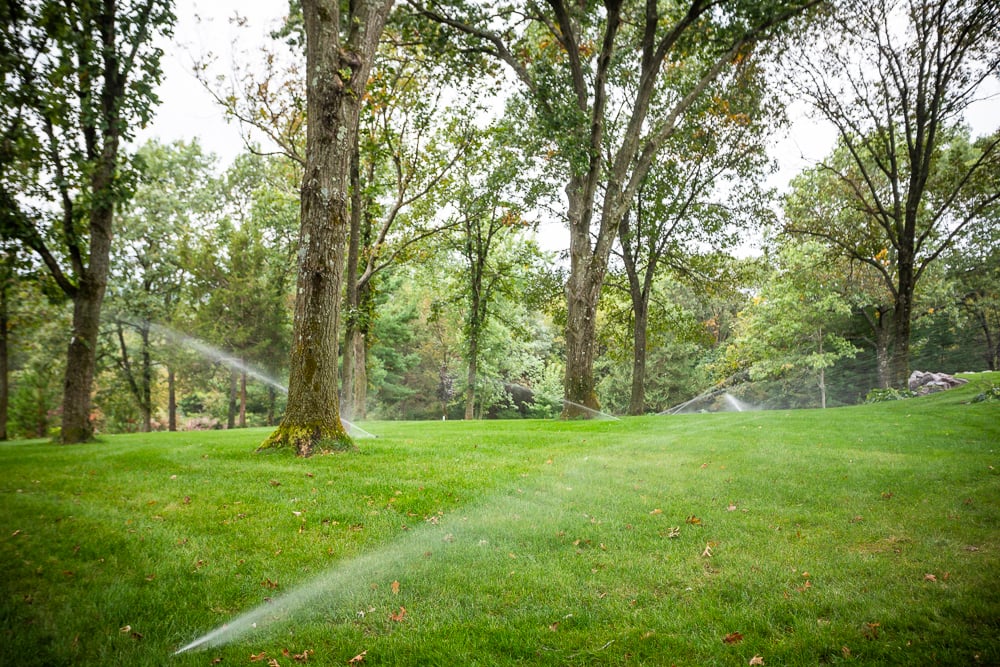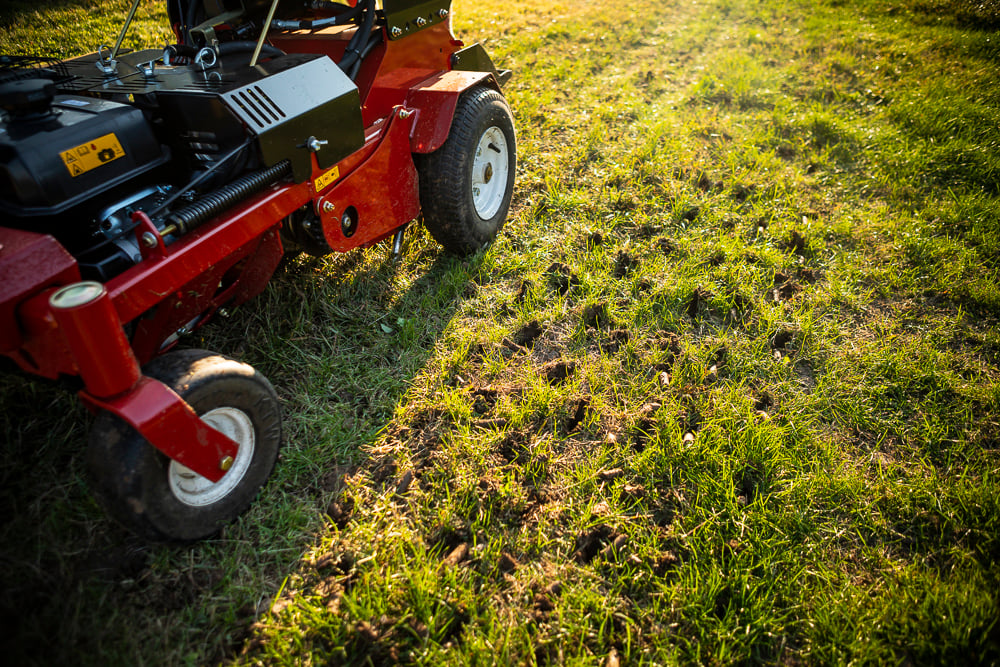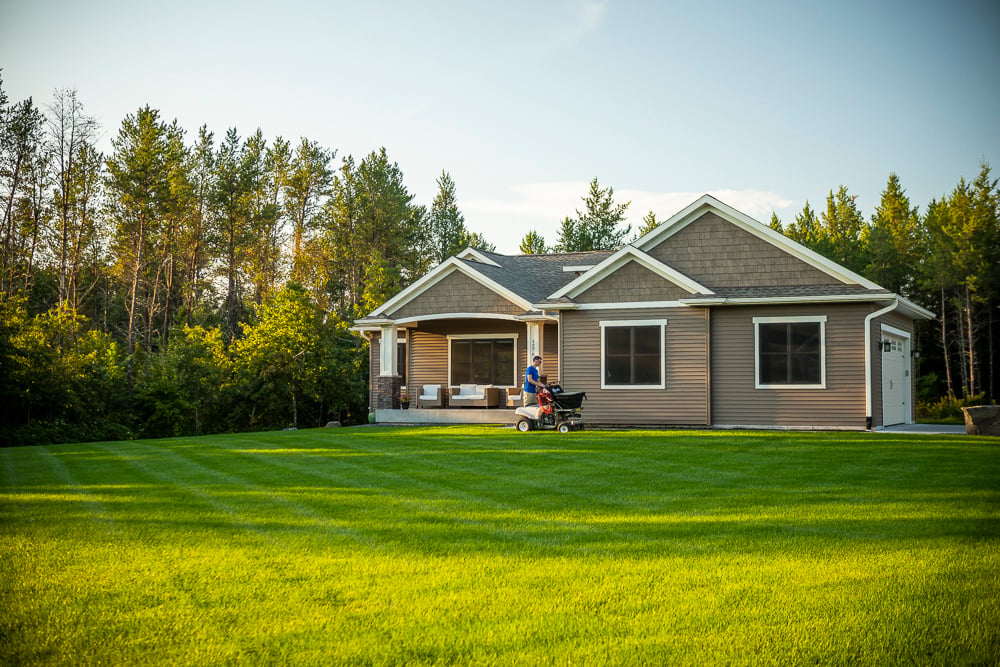Isn’t your new grass the most precious thing?
Do you have any new photos?
It grows so fast, doesn’t it?
Is it sleeping through the night? Lucky you!
Well, maybe we got a bit carried away with that last one, but new grass really is a lot like a baby.
New grass takes more work than an established lawn. A new lawn less than a year old needs pampering and extra care. Here are some tips on caring for new grass.
1. Use Starter Fertilizer & Fix the pH
This fertilizer designed for new grass helps it grow and get stronger.
It contains phosphorus and quicker-release nitrogen in smaller doses — your new lawn’s tender roots need quick access to these nutrients.
As your baby grass matures, it benefits from the slow-release nutrients in regular fertilizer.
You also may want to have your lawn care service test the pH of your soil and add the necessary limestone or gypsum to adjust the pH to the optimum level. Without doing so, your new grass plants will only be able to absorb a fraction of the available nutrients.
2. Keep Fertilizing Throughout The Year
Fertilizer isn’t a one and done deal. Would you feed your baby once, then ignore it for months while you watch Netflix?
A new baby eats multiple times a day. Your new lawn needs fertilizing throughout the year.
But not too much. Some homeowners figure if they feed their new lawn like crazy, it’ll grow faster. Nope. Babies need time to grow and develop, and so does your new grass.
3. How to Water New Grass: Extra Water at First
When your grass is new, it needs more frequent watering in smaller amounts.
This is the opposite of a watering schedule for mature grass, which needs less frequent watering but for longer periods of time.  After four to six weeks, transition to longer periods of watering but fewer times. You want your grass to have to search for water, sending its roots deeper into the soil. That encourages the roots to grow longer and deeper, which means your grass will be healthier.
After four to six weeks, transition to longer periods of watering but fewer times. You want your grass to have to search for water, sending its roots deeper into the soil. That encourages the roots to grow longer and deeper, which means your grass will be healthier.
Bonus lawn watering tip: don’t drown your new grass. Lots of people tend to overwater their new lawns, overestimating their thirst.
4. Don't Use Weed Killer on New Grass
Another tip to taking care of new grass, don’t use weed control products for at least a month. A good way to keep track: if you mow weekly, mow at least four times before you break out the weed control.
We know, it’s tempting.
New lawns are typically packed with weeds, and they usually grow faster than your new grass.
But that weed killer will also kill your precious new grass. So hold off.
The one exception: if we do your lawn care. We have a pro-level product that will kill weeds without harming your new grass. We can use it the day we seed.
5. Unexpected New Grass Tip: Aeration & Overseeding
Consider aerating your lawn in the first year, or at least the first two years. This is especially helpful for sodded lawns as they are more prone to disease initially vs. a seeded lawn that gets more air circulation at the soil level.  Why would your new lawn need aeration so soon? It’s too new to be compacted, right?
Why would your new lawn need aeration so soon? It’s too new to be compacted, right?
Aeration isn’t just for compacted lawns. It also loosens the soil and creates perfect little holes for great seed to soil contact to help your new lawn grow thicker.
Your new lawn may have some thin areas that need help each year as it continues to mature. Overseeding at the time of an annual aeration can help it to thicken up faster.
6. How to Mow New Grass
Mostly, the same rules apply here as for established lawns:
- Take care when the soil is wet. Don’t overwater if there is already ample moisture and be careful not to leave ruts in the yard with footprints, mowers, or other equipment.
- Mow high. Taller grass helps a lawn grow thicker and stay greener. As summer progresses, you should keep raising your mower blade. Shoot for 3 inches in June, 3.5 to 4 inches in July and August.
- Don’t mow wet grass. You don’t want clumps or to increase the chance for disease.
- Take it easy. Resist the urge to rev up your mower engine and spin the tires, no matter how cool it makes you look. You don’t want to damage that tender new grass. If you have new sod, give it a tug. Make sure the roots have a strong hold before you start mowing regularly.
7. Get Those Grubs
Grub control is always a good idea, and it’s fine to use it in the first year. The key to controlling grubs is to prevent them before they hatch and begin to cause damage to your lawn.
But if you’re starting your new lawn in the fall, you won’t need it. Grub season is over.
8. It Grows Up So Fast: Keep Up the Care
They don’t stay little for long, right?
The best tip to caring for a new lawn is to make sure your little lawn darling continues to grow strong and healthy with a proactive, comprehensive lawn care program designed to nourish your lawn each year so its roots are healthy, its blades are thick and lush, and weeds have a tough time taking hold.
9. New Lawn Care Tip for Eau Claire, WI or Minneapolis Homeowners: Trust Your New Lawn to RainMaster
Give your precious new grass a great start in life with a proactive lawn care plan to help it thrive.
That means all the good stuff: Fertilizer. Weed control. Aeration and overseeding. Grub Guard. Proper watering.
You choose from three different levels of lawn care programs, based on the results you’d like, how fast you want to see results, and your budget.
- Luscious Lawn is a high-end, proactive program that will promote amazing lawn care results. This is the program to choose for the quickest and best results, particularly if your lawn needs a lot of help.
- Terrific Turf, a mid-level option, is our most popular program to grow a thick, green lawn and deal with most challenges.
- Healthy Habitat is a basic plan that includes the elements you need for a better lawn.
When you’re ready to put your trust in us, we can’t wait to meet you — and help you make the best choices for your lawn.
Ready for the next step in lawn parenting? Request a quote today! We’ll review your lawn care options together so you can make a great choice. Then, you can finally enjoy watching your lawn transform and stop worrying about it.


